~ 23 Min read
Home > Resources > SaaS SEO Audit
CHAPTER 1
The history of Search Engine Optimization goes back to the time when the first Search Engine “Archie” was launched in 1990. However, it didn’t have a front-end graphical user interface and back-end complex algorithms to find, collect, and organize information. Fast forward to the late 90s, Excite, Wandex, Lycos, AltaVista, and Dogpile were introduced in the hope that they would help people find what they were looking for.
It wasn’t until 1996 that a website that would later revolutionize the search world was introduced. Initially known as BackRub, this search engine ranked websites based on their popularity and not alphabetically or with payments. Within these 20 years, this search engine has become a synonym for searching (Yes, BackRub was the first name of our beloved Google), so much that the word “search” is no longer used, the phrase “Google it” is enough. It has successfully dominated the search engine market, with about 88.47 percent market share as of April 2019.
Having derived its name from the popular mathematical term for a number 1 followed by 100 zeros (googol), Google is completely aligned with the reason it was given this name – to signify that the search engine was intended to provide large quantities of information. So the one thing search engines desperately want to accomplish is serve the perfect match for a search query. The sole focus of search engines is to provide value-jammed information to users. But how would they do that? Enter SEO.
With the expansion of the digital world, and the introduction of cloud-based services such as SaaS, IaaS, etc. search engines were viewed as key lead generators, which meant that the stronger your online presence, the higher are your chances of being spotted by a potential customer. It’s all about creating an impactful digital presence which will not only increase the quality and quantity of website traffic, but also strengthen your brand position; all this through a non-paid (or “organic”) search engine results.
To understand SEO – Search engine optimization, you need to know about Search engines. To state in simple words, search engines are answer generators that skim and evaluate billions of content pieces to find the one that is most likely to answer a searchers’ query. They do so by finding and marking the available content – “Crawling and Indexing”, and then placing them in an order to depict how well they match a query – “Ranking.” (This will be discussed in-depth in Chapter 3).
SEO was a grimy business a few years ago. You needed to invest in Private Blogger Networks (PBNs), buy and sell links, & use a lot of black/grey hat techniques to rank or defend your position.
Thankfully Google has evolved with time and with its Panda and Penguin algorithm, become much smarter! Search engines are doing their best to mimic the real world. Continuous algorithm updates are helping search engines display the best results for a search query, backed by proper research and filled with immense value.
So let’s put that in context. When you are hiring someone for a job, how do you shortlist candidates? You look at their resume to see where they have worked and what schools they attended and also look at what they have done at each place.
Let’s say they have worked at Goldman Sachs or the White House or went to Harvard or Yale; that automatically signals your brain to pay more attention to that particular resume. This is essentially what Google is also looking for; it’s looking for who has mentioned you on their site. If an authority site has mentioned you, it signals Google to take you more seriously. So (off-page SEO/link-building – discussed in Chapter 3 and 7) is one part of it.
The other part is on-page SEO and Contextual Relevance. So going back to the analogy, let’s say you are hiring for an engineering position and the person was the Top Chef at WhiteHouse with no engineering background – would you shortlist them? No!
That’s what contextual relevance is.

You can get a backlink from a top site but if it’s not relevant to what you do, Google is going to understand that, and not rank you or provide you that link juice.
Now that you understand Off-Page and On-Page SEO, let’s talk about Technical SEO. Let’s say that you have a Top Engineer from Goldman Sachs who went to Harvard applying for a relevant engineering position within your company – would you short-list them? Probably! What if the resume was written in German and you couldn’t read it? Sure you can make out some words, but it’s probably going to the garbage pile! That’s what Technical SEO (discussed in chapter 3) is. Google’s spider needs to be able to read your website to understand what you are all about!
So to summarize, your site should have:
This gives you a thumbs-up by linking a website or webpage having relevant, contextual content. That’s SEO today!
By improving the SEO of your website, you can work to expand your visibility on the search engines which in turn helps you to reach and engage more potential customers, which will simultaneously increase your chances of bringing-in targeted organic traffic.
“If we turned off all acquisition spend/effort today, would we still grow?”
If the answer is no – then SEO and Content Marketing should be your #1 Growth Channel.
SEM is a tap that turns off as soon as you stop spending on ads. PR increases brand awareness and may not have an immediate impact on subscription revenue.
Additionally, SaaS Buyers are conducting extensive product and competitor research to identify the best provider for them. Showing up #1 for relevant keyword searches helps you be front and center with your target customer. That is the power of SEO. Being at the right place at the right time.
SEO and Content Marketing is surely something that takes time to scale. But once you have laid the foundation, it is something that scales without further investment and while you sleep!
CHAPTER 2
CHAPTER 3
SaaS SEO Audit is more like a website evaluation that grades your website for its ability to appear in search engine results pages (SERPs) or you can call it your website’s “Google-ability”
Once an audit is complete you can work on improving the shortcomings of your website and boost your performance.
Broadly speaking, SEO Audit is classified into 4 categories:
Other key aspects of SEO that need a check are:
And much more. We will be discussing all of them one-by-one and also how we can improve each one of them thus increasing the overall SEO performance of your SaaS website.
Initially, you need to perform an on-page SEO Audit and when doing that you find answers to these questions:
Page titles in your website structure should be unique and within the specified character range. Furthermore, all webpages should have accurate meta descriptions that include one use of the page keyword. These descriptions should tell the user what the page is about as well as exactly what it offers. a well-written meta description can help you get more clicks.
Google bolds keywords in your meta tag. When people see the bolded keywords that they’re searching for in the meta tag, they’re more likely to click on your website which will increase your “Click Through Rate”. This will help you rank higher in Google. Make sure that all your description tags on your website are unique because each page on your website should be unique.
To figure out what your webpage is all about, Google looks at the title tag, description tag, and heading tags as well in order to decide what keywords to rank your page for. For SaaS companies, we recommend :
Use variations of your target keyword instead of generic file names.
Use hyphens to separate words in image files.
The alt tag is a short description of the image found in the image’s source code. For a description of the image, search engine crawlers rely on the text in the image’s alt attributes, so you should ensure that all images have an alt attribute. Keep the descriptions below 150 characters so that you don’t impact on page load speed.
For content, you need to conduct a proper keyword research strategy and implement the keywords in the correct manner. Keywords should be used properly and consistently.

As for SaaS companies, since their target audience will be technical people who might have completed their university degrees. So the Flesch Reading score should be ideally somewhere around 60 or lower than that.
Proper Internal linking on your site can help search engines move quickly through the important site content on your website. Pages that don’t have any internal links pointing to them are often known as orphan pages. While crawling, internal links tell the search engines that the content is important and distribute link juice through your site, helping improve each page’s rank. Google Search Console provides a great and important resource in their Links section.
We recommend Google Analytics to find your answers to these questions. There are few data points you want to examine in your user experience analysis:
Ideally, the bounce rate should be between 50% – 60%. If you want to make sure your bounce stays low, you need to have a good content plan, as well as strong backlinks. Bounce rate between 60% – 70% shows room for improvement. If it is above 90%, then you might need to rethink the content present on the webpage.
As already mentioned, images and videos can slow down your website and you might want to keep a check on them too. Make sure that your web server uses compression (e.g., using gzip plugin) to lessen data usage.
With more than 60% of Google searches coming from mobile devices now, it’s necessary to check whether your website is mobile-friendly or not. To ensure this, you can use Google’s Mobile-Friendly Testing Tool and you will see if Google considers your site optimized for mobile devices or not.
The longer users stay on your site, the more chances you get to convert them. If the average time spent on your website is less than 1 minute, then you definitely need to check the content and the topics on your website again.
For this, we will recommend having quality content on your website, content that your ideal customers might be looking for or interested in. This will effectively improve bounce rates and force users to stay on your site for longer.
An HTML sitemap will help people navigate easily through your website. If people can find every page on your website, they will interact with your website longer which will eventually decrease the bounce rate and hence improve your rankings.
Don’t forget to include a sitemap in the footer of your website.
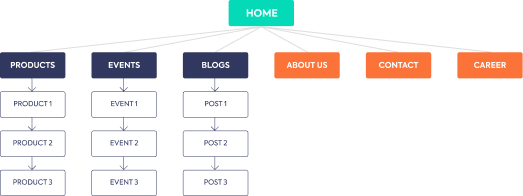
The only reason your business should have a website is to get conversions. If users are converting, then it won’t matter if you have a high bounce rate and if they are not, then it won’t matter if your bounce rate is low or people are staying on your website.
Analyzing the pages users are frequently leaving-from might help you tackle the issue at the root-level. A “normal” exit percentage should be around 50-65%.
This is a strong positive signal, if a user is revisiting your website, then your content is worth seeing. From a conversion standpoint, return visitors are good, as it gives you more opportunities to convert them into leads.
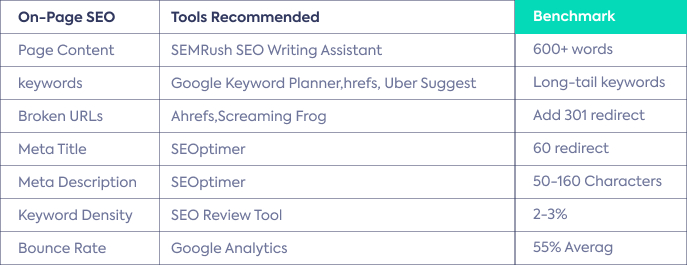
You need to make sure Google is indexing only one version, the version that you want. There can be versions like:

Now the next thing will be to check the web pages that Google isn’t indexing. For this, you can check the “Index Coverage” on Google Search Console that will display a list of pages that weren’t somehow indexed.
Your Website load speed can affect your search engine rankings and conversion rates too, thus making it an important SEO factor. For this, we suggest using Google Lighthouse / PageSpeed Insights by Google Developers (A score of 90 or above is considered fast, 50 to 90 is considered average and below 50 is considered to be slow).
The URLs of each of your web pages should be unique, properly formatted, and easy to understand both by the user as well as by the search engine. Instead of using default URL structures like :
Make your URL SEO friendly:
Tips for SaaS companies:
Make sure that your webpage’s at least 25% of your web page’s source code is text and not HTML. It’s simple. The more content you have, the more relevant your pages are to Google and you’ll rank higher.
Having secure access to your site gives Google the idea that your site is high quality and safe. For this, all you need to do is purchase an SSL certificate and install it with your hosting provider.
XML sitemaps tell the search engines about the web pages on your website and help gain an understanding of how well the search engines are indexing the content on your site. These should be dynamically generated, i.e., whenever a new page/post is published or removed from your site the sitemap should update as well.
In Google Search Console this is found under Crawl > Sitemaps, and in Bing Webmaster Tools it is found under Dashboard > Configure my site > Sitemaps.
To diagnose issues with ranking and driving traffic, you can divide your sitemaps by type of page so that you can view indexation for these buckets, such as features pages or blog posts.
For this, you need to check Google Search Console’s “Not Found” Tab under the “Crawl Errors” option.
To crawl a website, search engines follow links. This crawling behavior is sometimes known as “spidering.”
After arriving at a particular website but before spidering it, the search crawler will look for a robots.txt file (Note: robots.txt is case sensitive). If it finds one, the crawler reads that file first and then continues through the page. The robots.txt file contains information about how the search engine should crawl, the information found there will instruct further crawler action on this particular site, thus controlling indexation on a broader level than meta robots.
The robot.txt file is included in the root of your site and can be found here:
It serves two main purposes:
1. Disallows content you do not want to be crawled or indexed;
2. Link to your XML sitemap (which is also submitted to the search engines).
The robots.txt file by default looks something like this (this from a WordPress installation):
On the contrary, when a page or subfolder is blocked in robots.txt, that page is no longer crawled by the search engines, but this will not remove the page from the index. To remove a section of your site from the search engines and stop them from crawling, first implement a meta robots noindex and then block in robots.txt once the pages have dropped from the index.
Have a clean HTML or source code on your website as poorly written code makes it more difficult for search engines to crawl and understand. Check that your page is W3C validated – it meets the industry standard requirements for clean source code.
You can check this here:
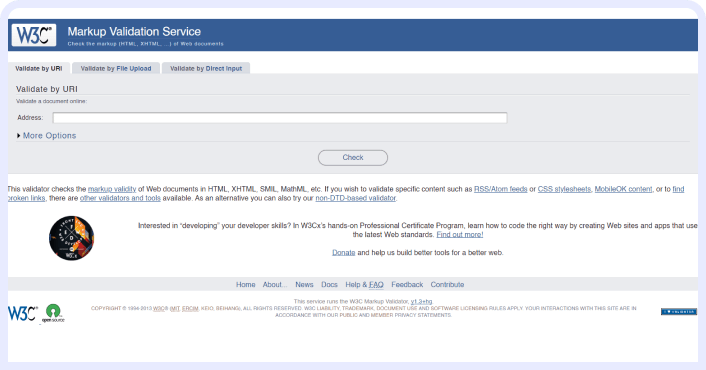
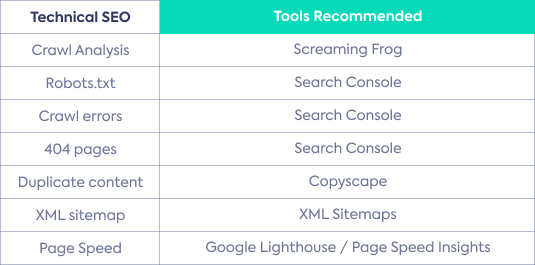
The SEO taking place externally, which helps search engines determine the level of trust, value, and authorship of your site.
Backlinks or the digital form of “Word of mouth” give your website credibility and the more true backlinks you have, the better traffic your website will drive which will eventually result in more conversions. Our recommended tool for this will be ahrefs (you can also use Moz). Here you need to check out referring domains & Domain Authority.
Based on the quality and quantity of your Backlinks, ahrefs will generate a number determining your Domain Authority. A higher value indicates better backlinks and higher domain authority. If in case you find some spammy looking links back-linked to your website, you might want to disavow them.
You also might need to check the broken links. You can use Google Search Console’s Index Coverage for this. Once detected, you can index the ones you want and if in case you deleted some pages, Google will eventually stop reporting these broken pages as problems.

Keeping a check on all the efforts you’ve put in your website or product is a smart way to figure out if there are any loopholes in your strategy. But what if something goes wrong with the tool you were using to keep a check on the rest of your strategies?
How often do you keep a track of whether your GA is capturing the right data or not? If your answer is “Not that often”, then it’s high time for a Google Analytics Audit.
GA Audit helps you analyze the quality of web data that is being captured by answering these questions:
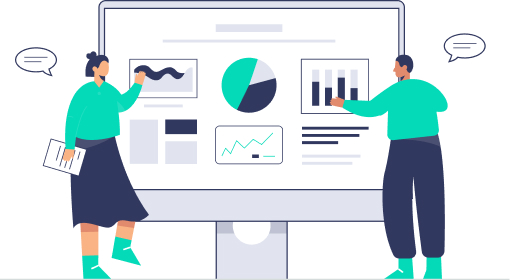
While conducting an analytics audit, your goal is to identify and track the points of failure and check the validation of the data being captured.
Here’s a basic GA audit checklist.
Assuming that you already have a Google Analytics account (setup here), otherwise you wouldn’t be auditing it in the first place, here’s how you can do it:
To check the overall setup of your Google Analytics account, the setup audit is conducted. Here’s what you need to find out when conducting this audit:
Ensure that at least one user has administrator privileges on the GA account and since all the three levels can be managed make sure you check the settings at all levels.
Check the account used to link products (10 can be linked as of now) and make sure you start using an administrative account.
Since only 20 custom dimensions and metrics are available for free, make sure you use them properly.
Review the definitions of segments and update them if necessary. Filters are great for data manipulation, so keep a check on that.
Check whether all the settings are correct for each of the GA property views.
Running your website under a crawl test will not only help you check for errors on your web pages but also give you a list of all the technical fixes your website might need. While running a crawl test on your website, here are some questions you need to find answers to:
You also might need to watch out for the following errors:
For a GA admin checkup, we just need to review whether or not all the settings are proper. For this we need to check the following parameters:
You need to make sure that you’ve keyed in all the fields in your property settings properly. From website URL to AdWord integration to search console, check the configuration once. Make sure you exclude all the URLs you don’t want a part of your extracted data and also filter out data from bots and internal IP addresses. Also check whether or not you’ve properly tagged your referral channels and paid campaigns, etc.
If you have already placed a GA tracking code on your webpages, you would want to know that it is collecting data from all of them properly. Also make sure the code isn’t repetitive, i.e., you haven’t placed the same code in multiple places.
If you’re using multiple Google Analytics accounts, check whether the tracking code is linked to the right domain or not. Also, if your buyer’s journey includes multiple domains, then ensure enabling cross-domain tracking. Here are some things you need to keep an eye on:
If you are running Google Ads, don’t forget to link your AdWords account to your GA account (you can combine the data on GA and Adwords by using auto-tagging) to track impressions, clicks, and ROI as well. Make sure both GA and your Adwords account are following the same time zones, and the PPC data is showing up in GA.
Here are some things you need to keep a check on:
You need to have edit access in analytics and administrative access to Adwords.
Google Tag Manager is used by a lot of companies in order to set up a GA account as it’s the easiest possible way.
But considering that everything and every setup has their own share of problems, it’s always advisable to keep a check. Here are some of the pointers you should keep a check on:
As far as a Search Console setup is concerned, here’s what you need to keep a track of:
Analytics audit is essential for the sustainability of your business and you wouldn’t want to make important business decisions and design strategies based on bad data. Once the analytics audit is complete, don’t forget to keep a record of all the data you were able to gather throughout this time as they will serve as a valuable asset of your analytics architecture and will help you maintain data quality over time.
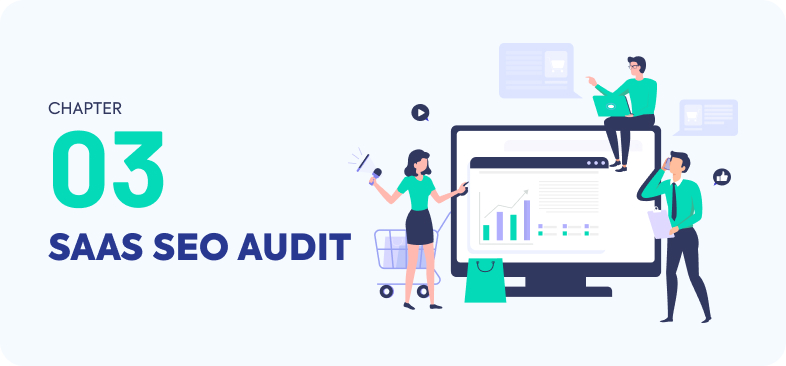
SaaS SEO Audit is more like a website evaluation that grades your website for its ability to appear in search engine results pages (SERPs) or you can call it your website’s “Google-ability”
Once an audit is complete you can work on improving the shortcomings of your website and boost your performance.
Broadly speaking, SEO Audit is classified into 4 categories:
Other key aspects of SEO that need a check are:
And much more. We will be discussing all of them one-by-one and also how we can improve each one of them thus increasing the overall SEO performance of your SaaS website.

Initially, you need to perform an on-page SEO Audit and when doing that you find answers to these questions:
Page titles in your website structure should be unique and within the specified character range. Furthermore, all webpages should have accurate meta descriptions that include one use of the page keyword. These descriptions should tell the user what the page is about as well as exactly what it offers. a well-written meta description can help you get more clicks.
Google bolds keywords in your meta tag. When people see the bolded keywords that they’re searching for in the meta tag, they’re more likely to click on your website which will increase your “Click Through Rate”. This will help you rank higher in Google. Make sure that all your description tags on your website are unique because each page on your website should be unique.
To figure out what your webpage is all about, Google looks at the title tag, description tag, and heading tags as well in order to decide what keywords to rank your page for. For SaaS companies, we recommend :
Use variations of your target keyword instead of generic file names.
Use hyphens to separate words in image files.
The alt tag is a short description of the image found in the image’s source code. For a description of the image, search engine crawlers rely on the text in the image’s alt attributes, so you should ensure that all images have an alt attribute. Keep the descriptions below 150 characters so that you don’t impact on page load speed.
For content, you need to conduct a proper keyword research strategy and implement the keywords in the correct manner. Keywords should be used properly and consistently.

As for SaaS companies, since their target audience will be technical people who might have completed their university degrees. So the Flesch Reading score should be ideally somewhere around 60 or lower than that.
Proper Internal linking on your site can help search engines move quickly through the important site content on your website. Pages that don’t have any internal links pointing to them are often known as orphan pages. While crawling, internal links tell the search engines that the content is important and distribute link juice through your site, helping improve each page’s rank. Google Search Console provides a great and important resource in their Links section.
We recommend Google Analytics to find your answers to these questions. There are few data points you want to examine in your user experience analysis:
Ideally, the bounce rate should be between 50% – 60%. If you want to make sure your bounce stays low, you need to have a good content plan, as well as strong backlinks. Bounce rate between 60% – 70% shows room for improvement. If it is above 90%, then you might need to rethink the content present on the webpage.
As already mentioned, images and videos can slow down your website and you might want to keep a check on them too. Make sure that your web server uses compression (e.g., using gzip plugin) to lessen data usage.
With more than 60% of Google searches coming from mobile devices now, it’s necessary to check whether your website is mobile-friendly or not. To ensure this, you can use Google’s Mobile-Friendly Testing Tool and you will see if Google considers your site optimized for mobile devices or not.
The longer users stay on your site, the more chances you get to convert them. If the average time spent on your website is less than 1 minute, then you definitely need to check the content and the topics on your website again.
For this, we will recommend having quality content on your website, content that your ideal customers might be looking for or interested in. This will effectively improve bounce rates and force users to stay on your site for longer.
An HTML sitemap will help people navigate easily through your website. If people can find every page on your website, they will interact with your website longer which will eventually decrease the bounce rate and hence improve your rankings.
Don’t forget to include a sitemap in the footer of your website.

The only reason your business should have a website is to get conversions. If users are converting, then it won’t matter if you have a high bounce rate and if they are not, then it won’t matter if your bounce rate is low or people are staying on your website.
Analyzing the pages users are frequently leaving-from might help you tackle the issue at the root-level. A “normal” exit percentage should be around 50-65%.
This is a strong positive signal, if a user is revisiting your website, then your content is worth seeing. From a conversion standpoint, return visitors are good, as it gives you more opportunities to convert them into leads.



You need to make sure Google is indexing only one version, the version that you want. There can be versions like:

Now the next thing will be to check the web pages that Google isn’t indexing. For this, you can check the “Index Coverage” on Google Search Console that will display a list of pages that weren’t somehow indexed.
Your Website load speed can affect your search engine rankings and conversion rates too, thus making it an important SEO factor. For this, we suggest using Google Lighthouse / PageSpeed Insights by Google Developers (A score of 90 or above is considered fast, 50 to 90 is considered average and below 50 is considered to be slow).
The URLs of each of your web pages should be unique, properly formatted, and easy to understand both by the user as well as by the search engine. Instead of using default URL structures like :
Make your URL SEO friendly:
Tips for SaaS companies:
Make sure that your webpage’s at least 25% of your web page’s source code is text and not HTML. It’s simple. The more content you have, the more relevant your pages are to Google and you’ll rank higher.
Having secure access to your site gives Google the idea that your site is high quality and safe. For this, all you need to do is purchase an SSL certificate and install it with your hosting provider.
XML sitemaps tell the search engines about the web pages on your website and help gain an understanding of how well the search engines are indexing the content on your site. These should be dynamically generated, i.e., whenever a new page/post is published or removed from your site the sitemap should update as well.
In Google Search Console this is found under Crawl > Sitemaps, and in Bing Webmaster Tools it is found under Dashboard > Configure my site > Sitemaps.
To diagnose issues with ranking and driving traffic, you can divide your sitemaps by type of page so that you can view indexation for these buckets, such as features pages or blog posts.
For this, you need to check Google Search Console’s “Not Found” Tab under the “Crawl Errors” option.
To crawl a website, search engines follow links. This crawling behavior is sometimes known as “spidering.”
After arriving at a particular website but before spidering it, the search crawler will look for a robots.txt file (Note: robots.txt is case sensitive). If it finds one, the crawler reads that file first and then continues through the page. The robots.txt file contains information about how the search engine should crawl, the information found there will instruct further crawler action on this particular site, thus controlling indexation on a broader level than meta robots.
The robot.txt file is included in the root of your site and can be found here:
It serves two main purposes:
1. Disallows content you do not want to be crawled or indexed;
2. Link to your XML sitemap (which is also submitted to the search engines).
The robots.txt file by default looks something like this (this from a WordPress installation):
On the contrary, when a page or subfolder is blocked in robots.txt, that page is no longer crawled by the search engines, but this will not remove the page from the index. To remove a section of your site from the search engines and stop them from crawling, first implement a meta robots noindex and then block in robots.txt once the pages have dropped from the index.
Have a clean HTML or source code on your website as poorly written code makes it more difficult for search engines to crawl and understand. Check that your page is W3C validated – it meets the industry standard requirements for clean source code.
You can check this here:




The SEO taking place externally, which helps search engines determine the level of trust, value, and authorship of your site.
Backlinks or the digital form of “Word of mouth” give your website credibility and the more true backlinks you have, the better traffic your website will drive which will eventually result in more conversions. Our recommended tool for this will be ahrefs (you can also use Moz). Here you need to check out referring domains & Domain Authority.
Based on the quality and quantity of your Backlinks, ahrefs will generate a number determining your Domain Authority. A higher value indicates better backlinks and higher domain authority. If in case you find some spammy looking links back-linked to your website, you might want to disavow them.
You also might need to check the broken links. You can use Google Search Console’s Index Coverage for this. Once detected, you can index the ones you want and if in case you deleted some pages, Google will eventually stop reporting these broken pages as problems.



Keeping a check on all the efforts you’ve put in your website or product is a smart way to figure out if there are any loopholes in your strategy. But what if something goes wrong with the tool you were using to keep a check on the rest of your strategies?
How often do you keep a track of whether your GA is capturing the right data or not? If your answer is “Not that often”, then it’s high time for a Google Analytics Audit.
GA Audit helps you analyze the quality of web data that is being captured by answering these questions:

While conducting an analytics audit, your goal is to identify and track the points of failure and check the validation of the data being captured.
Here’s a basic GA audit checklist.
Assuming that you already have a Google Analytics account (setup here), otherwise you wouldn’t be auditing it in the first place, here’s how you can do it:
To check the overall setup of your Google Analytics account, the setup audit is conducted. Here’s what you need to find out when conducting this audit:
Ensure that at least one user has administrator privileges on the GA account and since all the three levels can be managed make sure you check the settings at all levels.
Check the account used to link products (10 can be linked as of now) and make sure you start using an administrative account.
Since only 20 custom dimensions and metrics are available for free, make sure you use them properly.
Review the definitions of segments and update them if necessary. Filters are great for data manipulation, so keep a check on that.
Check whether all the settings are correct for each of the GA property views.
Running your website under a crawl test will not only help you check for errors on your web pages but also give you a list of all the technical fixes your website might need. While running a crawl test on your website, here are some questions you need to find answers to:
You also might need to watch out for the following errors:
For a GA admin checkup, we just need to review whether or not all the settings are proper. For this we need to check the following parameters:
You need to make sure that you’ve keyed in all the fields in your property settings properly. From website URL to AdWord integration to search console, check the configuration once. Make sure you exclude all the URLs you don’t want a part of your extracted data and also filter out data from bots and internal IP addresses. Also check whether or not you’ve properly tagged your referral channels and paid campaigns, etc.
If you have already placed a GA tracking code on your webpages, you would want to know that it is collecting data from all of them properly. Also make sure the code isn’t repetitive, i.e., you haven’t placed the same code in multiple places.
If you’re using multiple Google Analytics accounts, check whether the tracking code is linked to the right domain or not. Also, if your buyer’s journey includes multiple domains, then ensure enabling cross-domain tracking. Here are some things you need to keep an eye on:
If you are running Google Ads, don’t forget to link your AdWords account to your GA account (you can combine the data on GA and Adwords by using auto-tagging) to track impressions, clicks, and ROI as well. Make sure both GA and your Adwords account are following the same time zones, and the PPC data is showing up in GA.
Here are some things you need to keep a check on:
You need to have edit access in analytics and administrative access to Adwords.
Google Tag Manager is used by a lot of companies in order to set up a GA account as it’s the easiest possible way.
But considering that everything and every setup has their own share of problems, it’s always advisable to keep a check. Here are some of the pointers you should keep a check on:
As far as a Search Console setup is concerned, here’s what you need to keep a track of:
Analytics audit is essential for the sustainability of your business and you wouldn’t want to make important business decisions and design strategies based on bad data. Once the analytics audit is complete, don’t forget to keep a record of all the data you were able to gather throughout this time as they will serve as a valuable asset of your analytics architecture and will help you maintain data quality over time.